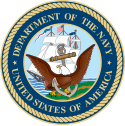William Shepherd Benson
| ||
 | ||
| Data i miejsce urodzenia | 25 września 1855 Macon | |
| Data i miejsce śmierci | 20 maja 1932 Waszyngton | |
| Przebieg służby | ||
| Lata służby | 1877–1919 | |
| Siły zbrojne | ||
| Stanowiska | szef Operacji Morskich | |
| Główne wojny i bitwy | I wojna światowa | |
| Odznaczenia | ||
William Shepherd Benson (ur. 25 września 1855 w Macon, zm. 20 maja 1932 w Waszyngtonie) – amerykański wojskowy, admirał United States Navy, pierwszy szef Operacji Morskich w latach 1915–1919.
Życiorys
Był synem Richarda Aarona Bensona oraz Catherine Brewer. Akademię Marynarki Wojennej ukończył w 1877, rozpoczynając służbę w US Navy. Jego pierwszym przydziałem był slup USS „Hartford”, później służył między innymi na kanonierce USS „Yantic” podczas misji ratunkowej, wysłanej do Arktyki dla ocalenia członków ekspedycji polarnej Adolphusa Greely'ego. W drugiej połowie lat 80. XIX w. uczestniczył w wokółziemskim rejsie kanonierki USS „Dolphin”. Podczas dalszej kariery w marynarce dowodził między innymi krążownikiem USS „Albany” i pancernikiem USS „Utah”, w latach 1913–1915 był komendantem Philadelphia Naval Shipyard.
Odwołany do Waszyngtonu, został awansowany do stopnia kontradmirała (Rear Admiral) i 11 maja 1915 objął stanowisko szefa Operacji Morskich. Jako pierwszy pełniący tę funkcję, stworzył ramy działania urzędu, pozostając na nim także przez cały okres zaangażowania Stanów Zjednoczonych w I wojnę światową. W 1916 awansował do stopnia admirała (Admiral). Po zakończeniu działań wojennych w listopadzie 1918 uczestniczył w negocjacjach traktatu pokojowego w Paryżu. Odszedł ze stanowiska 25 września 1919, przechodząc na emeryturę. Następnie przez niemal dziesięć lat zasiadał w zarządzie US Shipping Board.
Zmarł 20 maja 1932 w Waszyngtonie i został pochowany na Cmentarzu Narodowym w Arlington.
Pamięć
Na jego cześć nazwano dwa okręty US Navy: niszczyciel USS „Benson” oraz transportowiec USS „Admiral W. S. Benson”. Jego imię nosił też typ niszczycieli z okresu II wojny światowej.
Bibliografia
- William Benson. firstworldwar.com. [dostęp 2016-04-19].
- William Shepherd Benson. W: Arlington National Cemetery Website [on-line]. [dostęp 2011-09-10].
Media użyte na tej stronie
Ribbon for the Navy Distinguished Service Medal awarded by the United States Department of the Navy.
Ribbon for the Distinguished Service Medal awarded by the United States Army.
Ribbon for the Distinguished Service Medal awarded by the United States Army.
Naramiennik stopnia Admiral (United States Navy).
*Description: On a circular background of fair sky and moderate sea with land in sinister base, a tri-mast square rigged ship under way before a fair breeze with after top-sail furled, commission pennant atop the foremast, National Ensign atop the main, and the commodore's flag atop the mizzen. In front of the ship a luce-type anchor inclined slightly bendwise with the crown resting on the land and, in front of the shank and in back of the dexter fluke, an American bald eagle rising to sinister regarding to dexter, one foot on the ground, the other resting on the anchor near the shank; all in proper colors. The whole within a blue annulet bearing the inscription "Department of the Navy" at the top and "United States of America" at the bottom, separated on each side by a mullet and within a rim in the form of a rope; inscription, rope, mullet, and edges of annulet all gold. *Background: The policy for use of the Navy seal and emblem is contained in SECNAV Instr 5030.4 and SECNAV Instr 5030.6. The seal design was approved by the President of the United States by Executive Order 10736 dated October 23, 1957. Request for use of the Navy emblem should be submitted in writing to Defense Printing Service, ATTN: DPSMO, 8725 John Kingman Rd Suite 3239, Fort Belvoir, VA 22060-6220. The telephone number is (703) 767-4218. 1879 version here: http://etc.usf.edu/clipart/54900/54985/54985_seal_navy.htm
Flag of the United States Chief of Naval Operations. The position was created in 1915, but the flag just dates from 1964. It is defined in naval regulations, document NTP 13(B) [1] section 1810, as:
- The personal flag of the Chief of Naval Operations consists of a blue and white rectangular background divided diagonally from lower hoist to upper fly, blue above and white below. In the center of the flag appears an adaption of the center of the official seal of the Chief of Naval Operations, consisting of an eagle clutching an anchor, all in proper colors, encircled by fifty links of gold chain. Directly above, below and to each side of the circular center design is a 5-point star with one point upward. On the blue field the two stars are white and on the white field the two stars are blue. A gold fringe is authorized for use with the flag when it is displayed in a static indoor position. The cord and tassels are of golden yellow.
Ribbon for the Navy Distinguished Service Medal awarded by the United States Department of the Navy.







